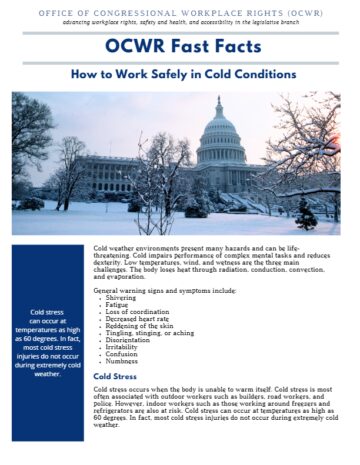Cold weather environments present many hazards and can be life-threatening. Cold impairs performance of complex mental tasks and reduces dexterity. Low temperatures, wind, and wetness are the three main challenges. The body loses heat through radiation, conduction, convection, and evaporation.
General warning signs and symptoms include:
- Shivering
- Fatigue
- Loss of coordination
- Decreased heart rate
- Reddening of the skin
- Tingling, stinging, or aching
- Disorientation
- Irritability
- Confusion
- Numbness
Cold Stress
Cold stress occurs when the body is unable to warm itself. Cold stress is most often associated with outdoor workers such as builders, road workers, and police. However, indoor workers such as those working around freezers and refrigerators are also at risk. Cold stress can occur at temperatures as high as 60 degrees. In fact, most cold stress injuries do not occur during extremely cold weather.
The following chart describes different illnesses that can result from cold stress, including their related symptoms and first aid methods recommended by the Occupational Safety and Health Administration and the National Institute for Occupational Safety and Health. In the event of an emergency, please seek attention from a medical professional.
Seek medical attention if you or your coworkers experience any of the following symptoms:
| Condition | Symptoms | Remedy |
| Frostbite | Numbness, aching, tingling, or stinging; and bluish, pale, or waxy skin. Most often affects nose, ears, cheeks, chin, fingers, or toes. | Get to a warm room as quickly as possible and avoid walking on frostbitten feet. To reheat the frostbitten area, immerse in warm, but not hot, water or use body heat. |
| Hypothermia | Loss of coordination and disorientation. In severe cases, blue skin, dilated pupils, and loss of consciousness. | Move the victim to a warm room and remove wet clothing. Warm the core of their body first, using blankets or skin-to-skin contact. If the person is conscious, warm beverages may help. |
| Trench Foot | Reddening of the skin, numbness, swelling, cramps, blisters, and bleeding under the skin. | Remove wet footwear and keep feet dry. |
| Chilblains | Redness, itching, blistering, and inflammation. | Slowly warm the skin, use creams to reduce itching and swelling, and keep any blisters or ulcers clean and covered. |
Prevention Tips
Since more accidents are likely to occur during cold conditions, it is important to take preventative measures. Measures include: environmental monitoring, engineering controls, and personal protective equipment.
- Monitor coworkers with conversation.
- Check the weather before and during your shift.
- When possible, avoid the wind, work in the sun, and seek shelter during breaks.
- Pace work to avoid sweating.
- Adapt equipment, such as covering handles with insulating material.
- Stay hydrated, even though you may not feel thirsty. Heavy clothing and gear, quickly evaporating sweat, and respiratory fluid lost through breathing can dehydrate the body.
- Dress appropriately, including gloves, coat, boots, hat, face mask, and long underwear. Take care to protect your extremities. Up to 10 percent of heat is lost through your head. When your feet are wet, you lose heat 25 times faster than when your feet are dry, so proper footwear is critical. Choose wool and synthetic fibers over cotton because they retain heat when wet.
- The National Oceanic and Atmospheric Administration (NOAA) broadcasts continuous weather information via NOAA Weather Radio. It monitors wind chill conditions and notes when they reach critical thresholds. A Wind Chill Warning is issued when wind chill temperatures are life threatening. A Wind Chill Advisory is issued when wind chill temperatures are potentially hazardous.
- The American Conference of Governmental Industrial Hygienists (ACGIH) provides a chart detailing appropriate warm-up schedules for a 4-hour shift based on temperature and wind.

